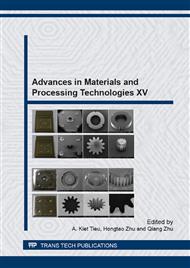[1]
W. Suchanek, M. Yoshimura, Processing and properties of hydroxyapatite-based biomaterials for use as hard tissue replacement implants, J. of Mat. Res., 13 (1998) 94-117.
DOI: 10.1557/jmr.1998.0015
Google Scholar
[2]
L.L. Hench, Bioceramics, J. of the American Ceramic Society, 81 (1998) 1705-1727.
Google Scholar
[3]
T. Kokubo, H.M. Kim, M. Kawashita, Novel bioactive materials with different mechanical properties, Biomaterials, 24 (2003) 2161-2175.
DOI: 10.1016/s0142-9612(03)00044-9
Google Scholar
[4]
S.R. Paital, N.B. Dahotre, Calcium phosphate coatings for bio-implant applications: Materials, performance factors, and methodologies, Mat. Sci.and Eng. R: Reports, 66 (2009) 1-70.
DOI: 10.1016/j.mser.2009.05.001
Google Scholar
[5]
C.C. Shih, C.M. Shih, Y.Y. Su, L.H.J. Su, M.S. Chang, S.J. Lin, Effect of surface oxide properties on corrosion resistance of 316L stainless steel for biomedical applications, Corrosion Sci., 46 (2004) 427-441.
DOI: 10.1016/s0010-938x(03)00148-3
Google Scholar
[6]
E. Chang, W.J. Chang, B.C. Wang, C.Y. Yang, Plasma spraying of zirconia-reinforced hydroxyapatite composite coatings on titanium Part I Phase, microstructure and bonding strength, J. of Mat. Sci.: Materials in Medicine, 8 (1997) 193-200.
Google Scholar
[7]
C. Chu, J. Zhu, Z. Yin, P. Lin, Structure optimization and properties of hydroxyapatite-Ti symmetrical functionally graded biomaterial, Mat. Sci. and Eng. A, 316 (2001) 205-210.
DOI: 10.1016/s0921-5093(01)01239-4
Google Scholar
[8]
C. Chu, J. Zhu, Z. Yin, P. Lin, Optimal design and fabrication of hydroxyapatite-Ti asymmetrical functionally graded biomaterial, Mat. Sci. and Eng. A, 348 (2003) 244-250.
DOI: 10.1016/s0921-5093(02)00738-4
Google Scholar
[9]
L. Sun, C.C. Berndt, K.A. Gross, Hydroyapatite/polymer composite flame-sprayed coatings for orthopedic applications, J. of Biomat. Sci., Polymer Edition, 13 (2002) 977-990.
DOI: 10.1163/156856202760319135
Google Scholar
[10]
A. Choudhuri, P.S. Mohanty, J. Karthikeyan, Bio-ceramic composite coatings by cold spray technology, Int. Thermal Spray Conf., ITSC 2009, (2009) 391-396.
DOI: 10.31399/asm.cp.itsc2009p0391
Google Scholar
[11]
F.N. Oktar, S. Agathopoulos, L.S. Ozyegin, O. Gunduz, N. Demirkol, Y. Bozkurt, S. Salman, Mechanical properties of bovine hydroxyapatite (BHA) composites doped with SiO2, MgO, Al2O3, and ZrO2, J. of Mat. Sci.: Mat. in Medicine, 18 (2007) 2137-2143.
DOI: 10.1007/s10856-007-3200-9
Google Scholar
[12]
Y. Chen, C. Gan, T. Zhang, G. Yu, P. Bai, A. Kaplan, Laser-surface-alloyed carbon nanotubes reinforced hydroxyapatite composite coatings, App. Phy. Letters, 86 (2005) 1-3.
DOI: 10.1063/1.1951054
Google Scholar
[13]
Y. Chen, Y.Q. Zhang, T.H. Zhang, C.H. Gan, C.Y. Zheng, G. Yu, Carbon nanotube reinforced hydroxyapatite composite coatings produced through laser surface alloying, Carbon, 44 (2006) 37-45.
DOI: 10.1016/j.carbon.2005.07.011
Google Scholar
[14]
K.A. Khor, Y.W. Gu, D. Pan, P. Cheang, Microstructure and mechanical properties of plasma sprayed HA/YSZ/ Ti-6Al-4V composite coatings, Biomaterials, 25 (2004) 4009-4017.
DOI: 10.1016/j.biomaterials.2003.10.089
Google Scholar
[15]
C.C. Berndt, G.N. Haddad, A.J.D. Farmer, K.A. Gross, Thermal spraying for bioceramic applications, Mat. Forum, 14 (1990) 161-173.
Google Scholar
[16]
S.R. Paital, N.B. Dahotre, Review of laser based biomimetic and bioactive Ca-P coatings, Mat. Sci. and Tech., 24 (2008) 1144-1161.
DOI: 10.1179/174328408x341825
Google Scholar
[17]
J. Mazumder, D. Dutta, N. Kikuchi, A. Ghosh, Closed loop direct metal deposition: Art to Part, Opt. and Lasers in Eng., 34 (2000) 397-414.
DOI: 10.1016/s0143-8166(00)00072-5
Google Scholar
[18]
J. Mazumder, H.L. Robert, Past present and future of art to part by Direct Metal Deposition, PICALO 2004 - 1st Pacific International Conference on Applications of Laser and Optics, (2004) 11-19.
DOI: 10.2351/1.5056164
Google Scholar
[19]
J. Mazumder, A. Schifferer, J. Choi, Direct materials deposition: Designed macro and microstructure, Mat. Res. Inno., 3 (1999) 118-131.
DOI: 10.1007/s100190050137
Google Scholar
[20]
R. Comesaña, F. Lusquiños, J. del Val, T. Malot, M. López-Álvarez, A. Riveiro, F. Quintero, M. Boutinguiza, P. Aubry, A. De Carlos, J. Pou, Calcium phosphate grafts produced by rapid prototyping based on laser cladding, J. of the Euro. Cer. Soc., 31 (2011) 29-41.
DOI: 10.1016/j.jeurceramsoc.2010.08.011
Google Scholar
[21]
B. Leon, J.A. Jansen, Thin Calcium Phosphate Coatings for Medical Implants, 2009 ed., Springer science, New York 2009, pp.30-31.
Google Scholar


